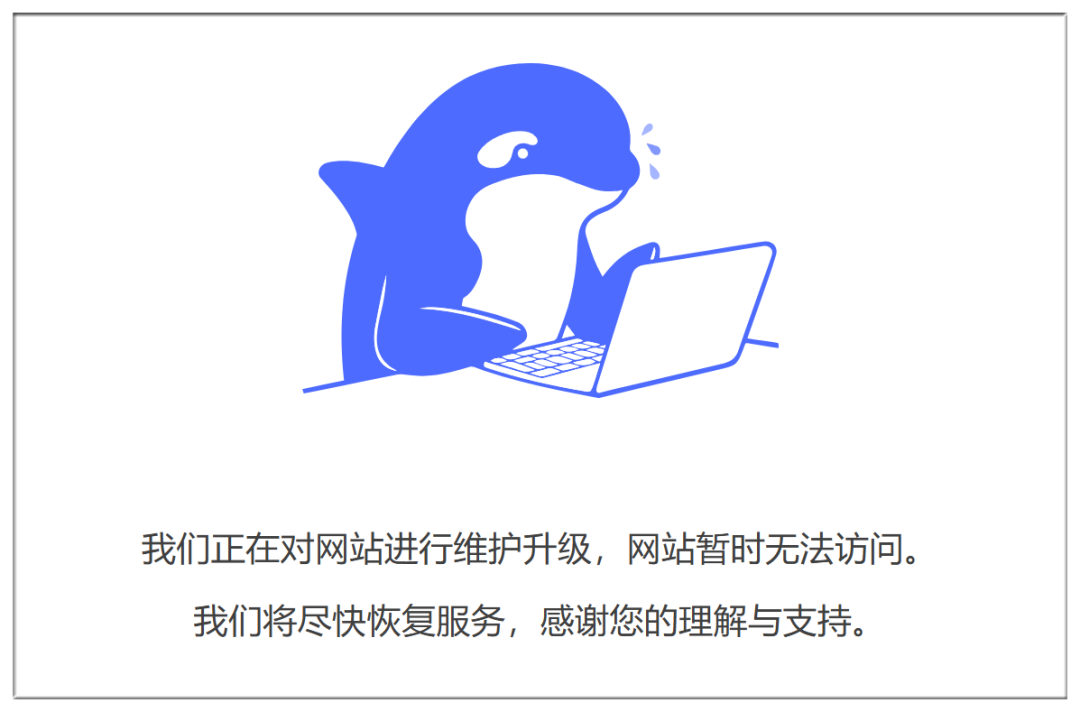AI education track 10,000 words analysis: what are the representative products? What are the opportunities? What are the future possibilities?
Education has long been considered one of the industries that will be changed the most by LLM. education makes up a large portion of ChatGPT's usage scenarios, and its usage often fluctuates with the start of the school year and the regularity of vacations. Andrej Karpathy has chosen education as the direction of his venture. People are looking forward to having all-round AI Tutor to teach according to the material and provide the best and most personalized education to everyone.
Although the ideal of AI Tutor has not yet been realized, startups are unlocking more and more application scenarios in the education field with the continuous improvement of AI capabilities such as LLM, Voice Agent, multimodal understanding and o1. At the core of LLM+EdTech, it is the transformation of traditional education services into products. This trend is especially obvious in niche areas such as language learning and photo search. For example, language tutors based on LLM and Voice Agent lower the threshold of foreign tutors through natural dialog enhancement; photo search applications based on multimodal understanding provide more accurate answers to picture-based questions. o1's launch also opens up new possibilities for math and logical reasoning-related subject scenarios.
And the value of application layer startups is to provide ChatGPT and other big models can't do the experience - to provide features that better understand users' needs and better fit the actual scenarios. For example, by optimizing product design so that users are more willing to interact in the product and get more direct feedback.
This article is our mapping of the AI & Edu track, we are always looking forward to the changes that AI will bring to the education industry, which is reflected in all aspects of teaching.Class companion is a typical example. The first step is to make sure that you have the right tools for the job, and that you have the right tools for the job. Driving school purchases through teacher word-of-mouth. However, as a tool for niche scenarios, Class Companion also runs the risk of being squeezed by the large school access software vendors. Nevertheless, this case shows that LLMs at this stage can unlock high enough pedagogical value as long as they find the right application scenarios.
AI & Education Track Overview
Educational products can be simply segmented according to whether the target customer is a student or a teacherThe products for students include language learning apps such as Duolingo, homework helpers such as Chegg and Quizlet, vocational skills training programs such as Coursera and Udemy, and early childhood education tools. Products for students mainly include language learning apps (e.g. Duolingo), homework helpers (e.g. Chegg and Quizlet), vocational skills training courses (e.g. Coursera and Udemy), and early childhood education tools (e.g. Ello). Product polish and efficiently reaching C-suite users are important.The global EdTech market reached $146 billion in 2023 and is expected to grow to $549.6 billion by 2033, with a market share of about 70% for individual students.
Products for teachers and school districts include learning management systems (e.g., Google Classroom), student information systems (e.g., PowerSchool), classroom management software (e.g., Classcraft), and assessment software (e.g., Gradescope). The success of these products relies heavily on the team's ability to sell and resources within the education system, with the main payers being schools and educational institutions. Although the market is smaller than the student side, it is growing rapidly, with a market size of approximately $18.5 billion in 2023, and expected to increase to $132.4 billion by 2032, growing at a CAGR of 25.21 TP3T.
The arrival of LLM provides an opportunity to unlock more personalized, immediate, and interactive educational scenarios.Due to limited educational resources, it is impossible for everyone to get the most suitable education anytime and anywhere. Several iterations of the education industry: online education platforms, learning resource websites, and learning apps have made up for the lack of education resources. lLM further enriches the supply of high-quality education resources.

AI X Edu Landscaping
To Students is mainly a 7/24 AI tutor, including specialized tutors for language learning, math, code, etc. Such as Speak, Praktika, Duolingo for language learning, question.ai, answer.ai for math, and all-around AI tutors such as Khan Academy's kehamigo, Chegg study's cheggmate, and byte's Gauth. AI tutors such as Khan Academy's kehamigo, Chegg Study's cheggmate, and Byte's Gauth, as well as early reading/curiosity coaches for kids such as ello.
Other application scenarios include psychological support and college/career counseling.To teachers & class room products are divided into pre-teaching, teaching, and post-teaching. To teachers & class room products are divided into pre-teaching and post-teaching. Before teaching, they are used for course generation and teaching suggestions; in the classroom, they are used to facilitate interaction and help teachers control students' learning status in real time; and after class, they are used to help correct homework and provide assessment and feedback to students. For example, OpenAI invested in class companion It is a saas product that focuses on after-school written assignment correction.
Language learning and children's educational applications have been more maturely developed, because of the high demand for real-time interaction, but the low demand for logic and precision, and the relatively low demand for model intelligence.
Subjects such as Math/Programming AI Tutor that require a high degree of precision and emphasize logic in problem solving require a high degree of model intelligence.Still focusing on the traditional photo→search question bank to solve questions, LLM is still in the early stage of Gen-AI application as an additional function of "good to have", but because of the large market space in this field, there is still a large space for development in the future with the intelligent enhancement of LLM.
The all-round AI tutor requires a lot of data, teaching and research accumulation. Currently limited by the lack of model intelligence, large companies have an advantage in this direction.For example, Khanmigo, launched by Khan Academy, is officially used by 65,000 students. Khanmingo currently offers customized learning paths and advice based on each student's progress and needs; instant feedback as students practice with Khanmigo, mainly in math and science subjects; and interactive learning capabilities with simulated conversations and question-answer sessions that guide students step-by-step through their thinking.
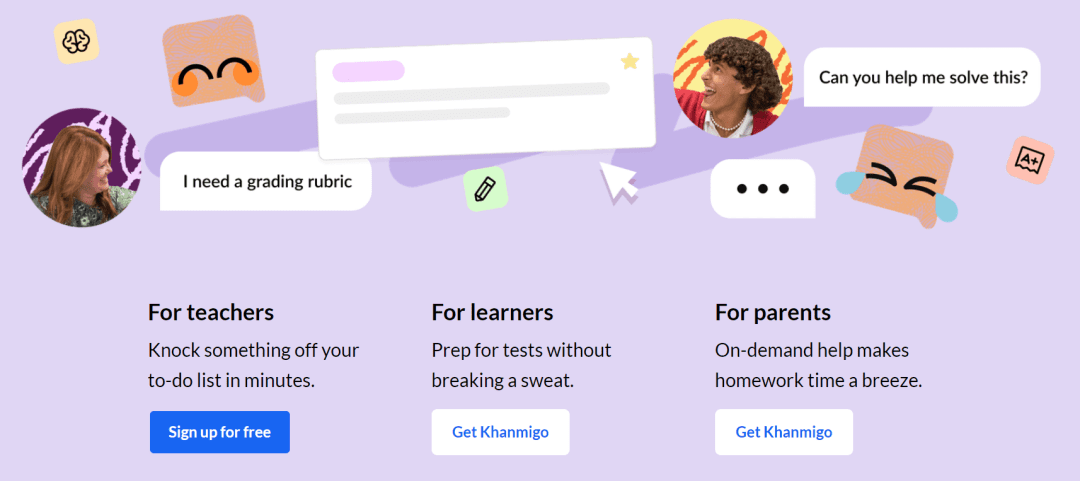

However, according to user feedback, khanmigo is currently only able to solve problems in the lower elementary school grades, and is less effective for more difficult problems. It can be seen that relying on the GPT4 level of intelligence is not enough to solve math and physics teaching problems, and it is difficult to reach the all-round AI tutor.
Introduction to educational products with different interactions
Modeling capabilities bring changes to the educational experience, adapted product forms, and representative case
It is quite intuitive to reflect "model capability improvement and unlocking different application scenarios" in the education field. We have divided the current AI application scenarios into quadrants based on the requirements of educational products for interaction/real-time and model reasoning capabilities. With the development of GPT-4o level end-to-end model to realize better interaction effect, multi-modal understanding, multi-modal output capability, and the reduction of model calling cost, it will bring better education experience.

GPT-4o level interactions
(LLM+Voice Agent)
GPT-4o is the first big model that enables end-to-end voice-in, voice-out. This technology path is the beginning of the next generation of interaction: low latency and high intelligence. While long-link latency is unacceptable to users, 4o makes it possible to reduce latency and add acknowledge signals to make user interaction more like communicating with a real person. This is significant for educational scenarios with high interaction/real-time requirements. Typical scenarios include Language AI tutor, Kids reading/curiosity coach.
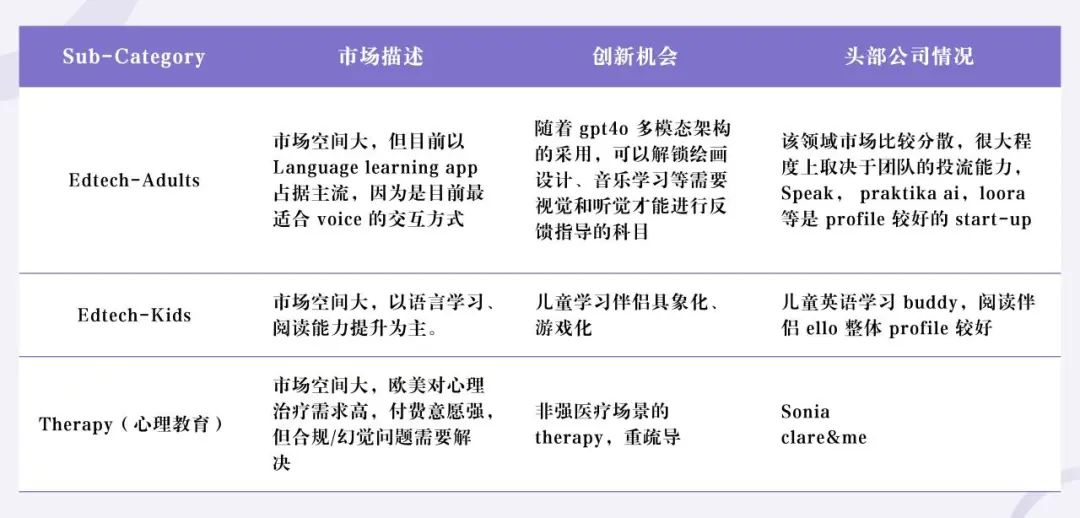
Speak (progress)
Funding: Latest funding of $20M (led by Buckley Ventures, followed by OpenAI startup fund, yc co-founder Paul Graham, LinkedIn CEO Jeff Weiner), doubling the valuation to $500M.
Users: says it now has more than 10 million users globally, with a user base that has doubled every year for the past five years and reaches more than 40 countries.
Courses: A new Spanish course is currently available, with a French course to follow.
Product: Launched "AI Chat", which allows users to create their own chat scenarios to have English conversations. (Experience is mediocre, not as good as c.ai and the AI tutor in the GPT-4 store)

Praktika
Product: Praktika uses GPT-4+Unity Avatars+11labs to create an AI tutor in the form of a voice agent, providing Avatars with different regional accents to simulate real conversations, helping users overcome language barriers and improve communication skills.
Differences: Targeting users with actual English communication needs, such as professional needs, studying abroad, etc. Compared with its competitors, Praktika focuses more on the imitation of real conversations, and Avatar is its feature.

Ello
A reading companion app for kids, designed for kids in kindergarten through third grade to help them develop reading habits.
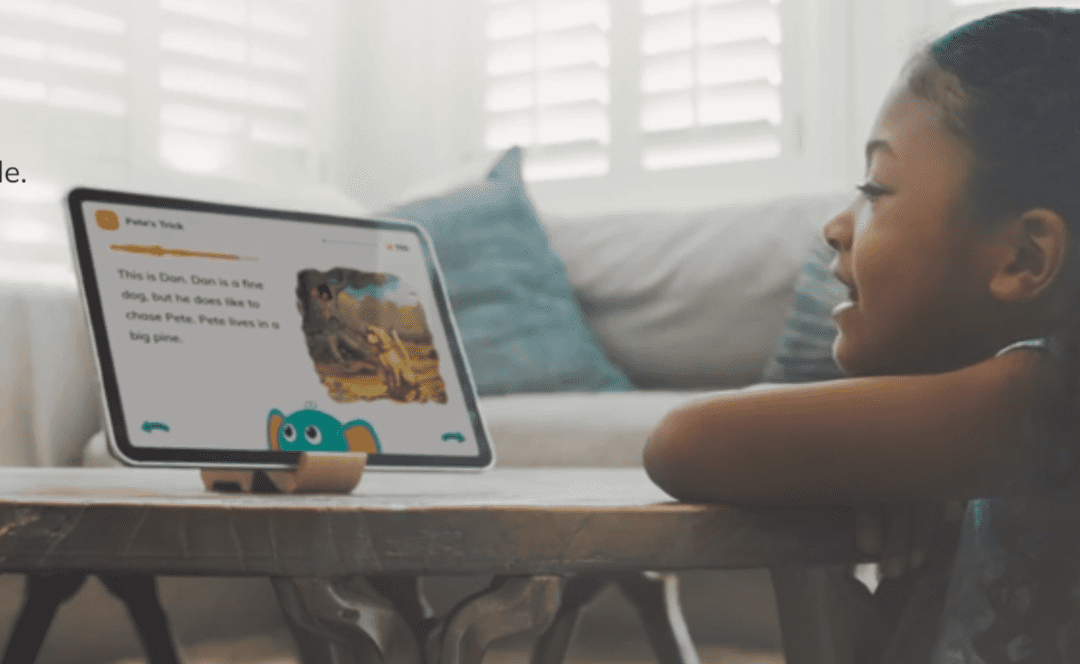
Adaptive Learn™ Technology: Ello's AI engine that understands, adapts and responds to each child's needs like a one-to-one teacher. ( not llm)
Graded Readers: provides e-books and paper books that match your child's reading level and interests.
Sonia
Developed AI-driven Cognitive Behavioral Therapist (CBT) to provide mental health therapy services in voice and text sessions. Provides users with a cost-effective, accessible, and ready-to-use mental health treatment solution that improves access to mental health services.
Specific applications:
1) AI Therapist: Sonia provides a full therapy session via a mobile app where users can choose to communicate with an AI therapist via voice or text.
2) Sonia offers a $200 annual subscription, which greatly reduces the financial burden on users compared to the traditional $200 per treatment.
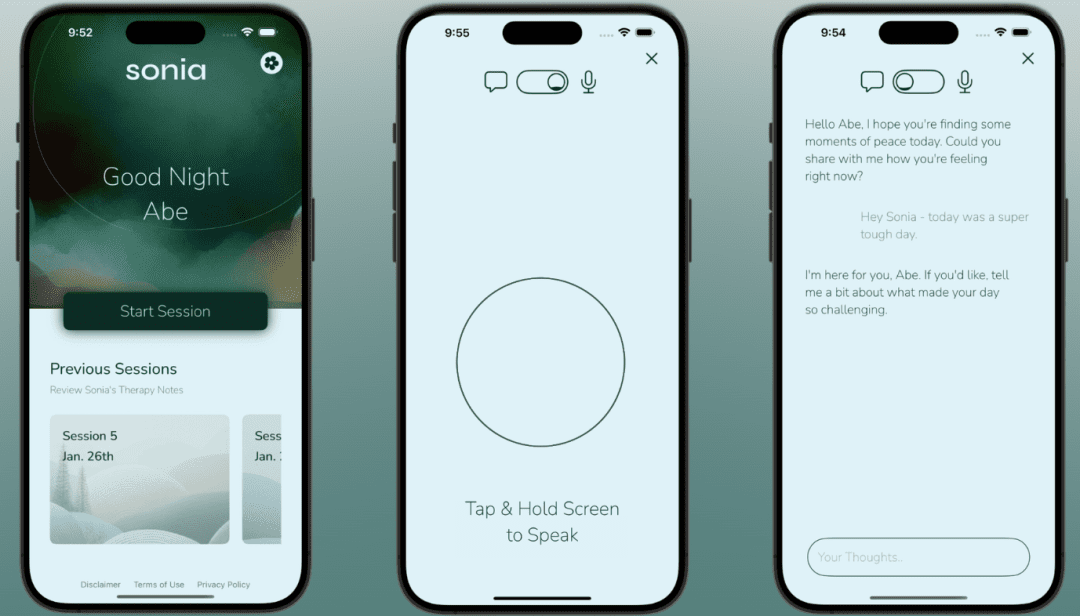
Multimodal comprehension and model generalization skills - Photo solving class
PatSoar is a scene and requirement that has been validated in the previous generation of education AI. After LLM, especially with the improvement of model reasoning ability and multimodal ability, the product of Photo Search has also been upgraded accordingly. Multimodal understanding is of great significance for photo solving scenarios, the main difference is that from relying solely on the question bank to relying on the knowledge of the big model, the solution steps can be answered step by step.GPT-3.5 to GPT-4 has greatly improved the solution rate of SoSuo, and after GPT-4v supports multimodality, graphical questions, such as geometry, diagrams, and physics questions can be done.
Specifically, with current modeling intelligence capabilities:
- American middle school students solving problems can do 85%, before the U.S. companies can only reach 60%, and although China can do 80%, the reason is that there is a large number of manpower assembly line, which is overseas is difficult to land, not generalized at all, and involves copyright;
- Multi-modal graphical type questions can be solved up to 60% (probably not enough data level for training);
- In the past, the product would get stuck if the user didn't understand one of the steps and the answer was abbreviated; before, you could only ask a real person, but now you can ask follow-up questions;
- The sticking point is comprehension, which may not be solved by the foundation model, and you need to make your own small model.
Over the past six months, we have observed that there Answer.ai Such startup teams, but also big players Gauth and Question.ai have entered the field.
Answer.ai
Answer.ai is currently the representative Startup in the field of searching topics.
Answer.AI is an All in One Learning App that features problem solving, concept explanation, memorization, and review tests. AI's AI problem solving focuses on identifying and presenting the math concepts involved in the questions, and the interactions are more detailed.Answer.AI's monthly membership is currently priced at $9.9/month, and subscribers can enjoy benefits including unlimited AI interactions and 500 Super AI (GPT-4) responses.




After the user searches for an answer, the App will pop up three options: explaining the knowledge point, pushing similar questions, and recommending videos of real people answering questions. One of the real answer video mainly from YouTube, for clicking will jump to YouTube to watch, equivalent to the ready-made public resources directly integrated into the product, if the students still have doubts can also continue to interact through text / voice.
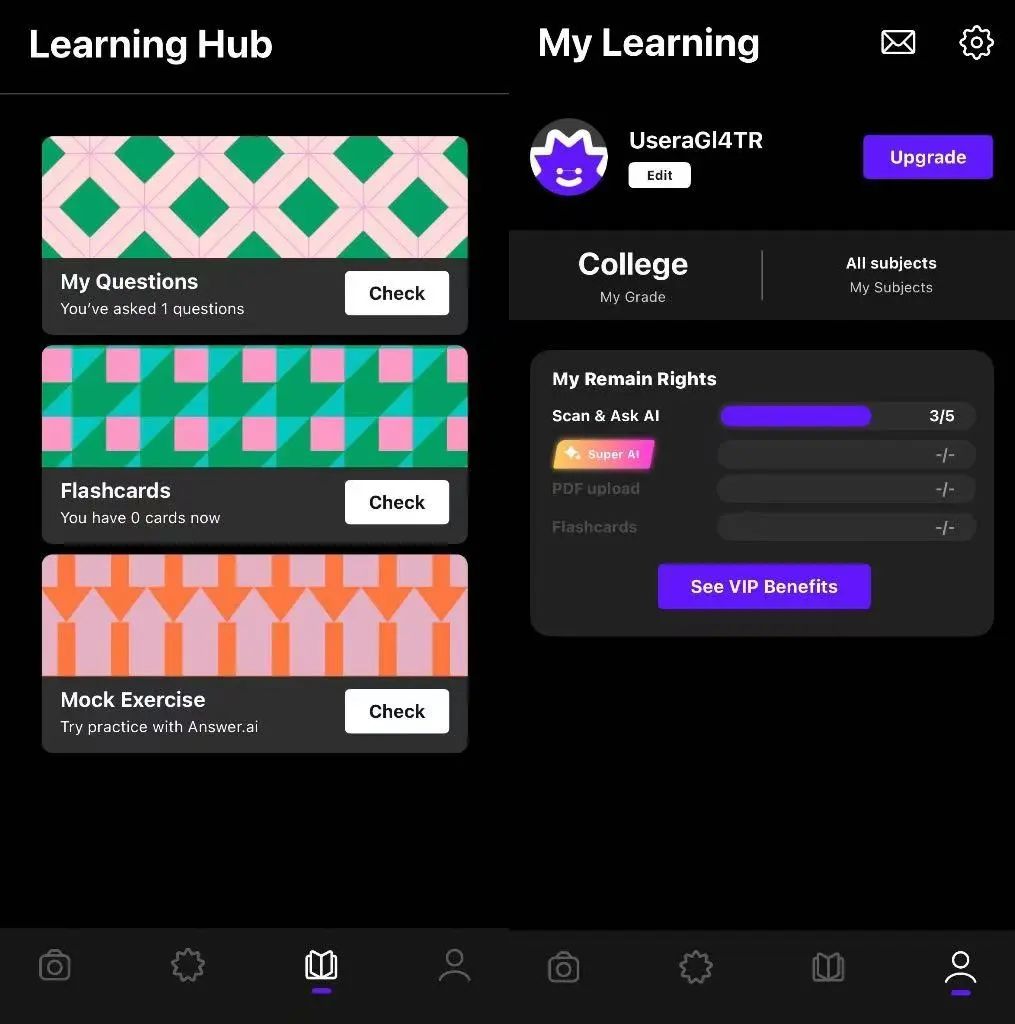
Question.ai
Homework Help's AI education app launched overseas, Question.AI went live in the U.S. market on May 30, 2023, followed by Southeast Asia and other markets around the world in June and July, according to Dot Data.
The landing page is the AI ChatBot, where users can directly enter the question they want the AI to solve. If users need to use the photo solving function, they can directly click the button above the chat box to enter the photo page. There are also AI writing related functions.

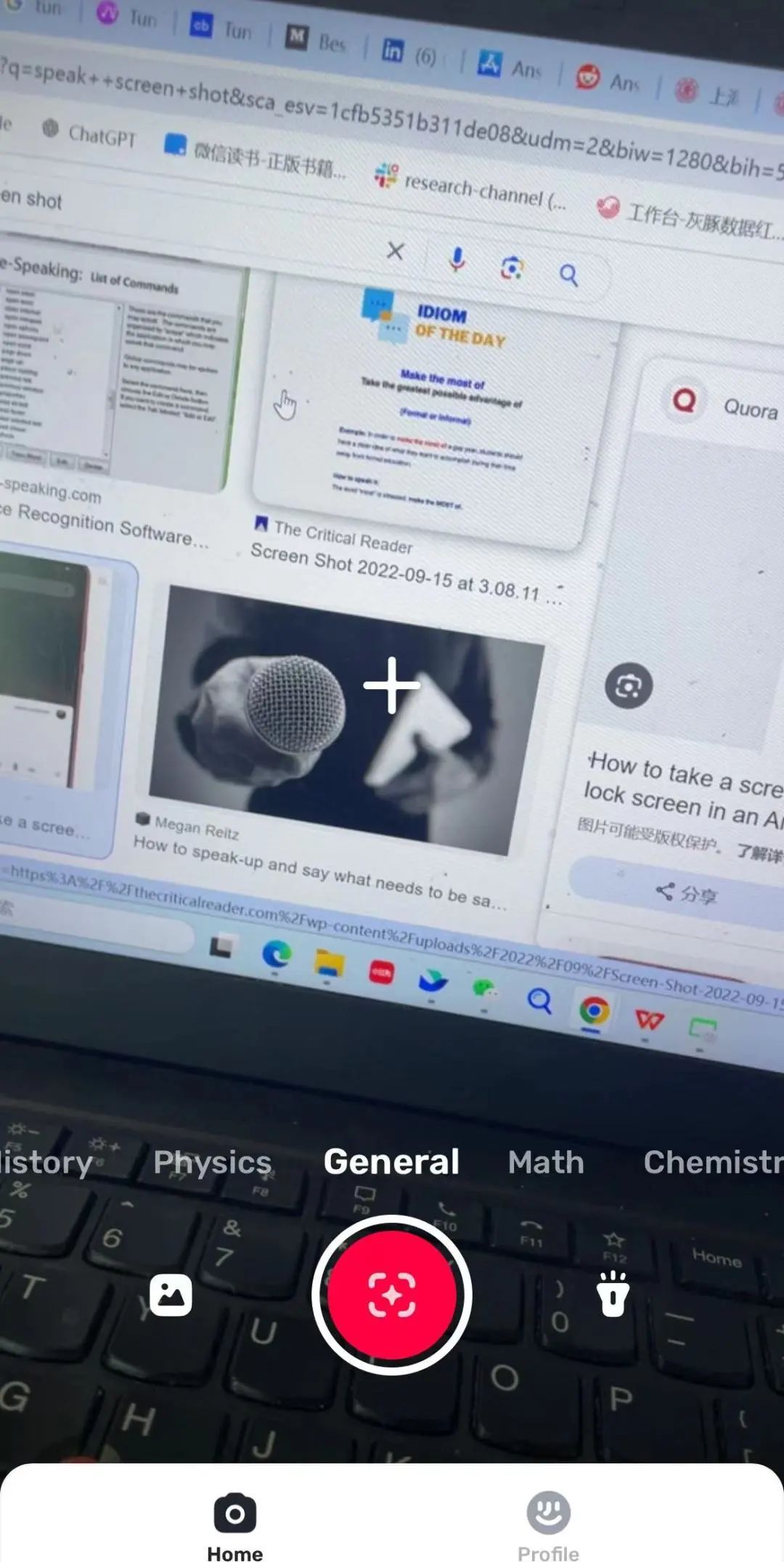


Gauth
Byte's was launched in December 2020 under the name Gauthmath, then the product name was Gauthmath, which mainly promoted real people 1v1 question answering, and later gradually built up the resources of math question bank, also supporting question bank searching.2023 by Gauthmath renamed Gauth AI, expanding from math to disciplines in terms of subject content, Gauth AI is based primarily on GPT-4 and Bard .. The product design is relatively simple and abbreviated in the explanation of the title.

Model call cost reduction 90%
Many AI education products, including duolingo max, speak, praktika, full ai tutor cheggmate, etc., have limited large-scale adoption due to the high cost of LLM and TTS invocation, which has resulted in high pricing or limited usage of the products. Over the next 1-3 years, the cost of model invocation is expected to decrease significantly. This will allow organizations to offer services at lower prices. Promote use by people who think it is "good to have" but too expensive.
Class Companion products
Class Companion is an after-school assignment management system designed by Avery Pan and Jack Forbes for K12 teachers, currently focusing on written/essay assignments for middle and high school courses.Our core judgments about class companion are as follows:
1. Class Companion is a win-win situation for both teachers and students, synchronizing efficiency and quality. Teachers are relieved of the burden of correcting assignments and improve their work efficiency, while students get instant feedback, based on which they can continuously improve and enhance their learning experience.
2. Clear target market and commercialization path: class companion, as a product for school districts and teachers, cuts into the budget of the K-12 education system and focuses on the U.S. market, which has a strong ability to pay, as the first step. class companion leverages the access and initiative of teachers in U.S. schools to purchase the software and lets teachers try it out and recommend the product to PLGs, so that they can purchase the product from the bottom up. Class Companion leverages the authority and initiative of U.S. school teachers to purchase software by allowing them to try and recommend the product PLG.
3. The founding team has comprehensive capabilities to fulfill the picture of building education ToB LLM products: class companion is geared towards teachers and school districts at the B-end, testing the team's understanding of AI on one hand, and its sales ability on the other. The founder, Avery Pan, is a former teacher and head of global product growth at outschool, and other team members have experience in serial entrepreneurship and LLM product development.
But there are some concerns about the future.
4. Limited market space in terms of the market space and product formations in which it operates:
a. School systems have limited budgets, and the global K-12 EdTech market will only be $18.5 billion in 2023. This in turn involves a lot of top-down purchasing within the school system.
b. Class Companion addresses very small scenarios with a low ceiling. Only by expanding the product line, for example, from only addressing homework feedback scenarios to course learning, after-school homework, and course quizzes, will it be possible to expand the imagination of the product.
5. Competition dimension, although there are no other after-school homework management software assisted by LLM in the market, there are opportunities for traditional teaching assessment software to add similar functions and gain price advantages through bundled sales, and there are opportunities for student-oriented problem solving tools such as Chegg to launch ToB products. And currently class companion only does one part of teaching and learning, which is easy to be replaced by full-featured into-school software by adding new components.
ToB Education Market Opportunities
In addition to the familiar student-oriented products in the education market (e.g., Duolingo, a language learning app, and Chegg, an after-school homework helper), there's a plethora of in-school software for teachers and school districts, categorized below:
Learning Management Systems (LMS): such as Google Classroom and Canvas, which help teachers manage course progress, distribute assignments, and track student progress, similar to project management software in an organization.
Student Information System (SIS): e.g. PowerSchool, collects and stores student data.
Classroom learning software: e.g. Classcraft, tools used in the classroom to support teaching and learning, e.g. motivating students through gamification, helping teachers to better enliven the classroom.
Assignment assessment software: such as Gradescope and Albert.io, which help teachers create assignments online, correct them, and provide simple feedback to students.
Into School Software is a part of the K-12 EdTech Expense market, which includes the total spending by educational institutions, governments, and private entities worldwide on technology solutions customized for K-12 students and educators. The market, which is projected to have a volume of $18.5 billion in 2023 according to Market.US, includes hardware (computers and interactive whiteboards), software (learning management systems and educational applications) services. This market is small relative to the market for individual student-oriented tutoring, which is expected to grow at a CAGR of 25.2% to reach $132.4 billion by 2032.


K12 classrooms in the U.S. are highly informatized, and school entry software is a well-developed market with a number of successful startups. 2010 is the year when smart devices began to enter the U.S. classroom. American primary and secondary school students have an iPad or laptop in the classroom, and the campus is fully covered by WiFi. Teachers in the classroom will synchronize the use of specialized educational websites, such as Coggle, Compass Learning, kahoot, etc., to complete a number of classroom interactions and quizzes.

Compared with the ToC market, into the school software market payers are mainly schools and educational institutions, product iteration is slow, in addition to the effect of the product, but also consider the replacement cost, the relationship between the interests of the education system, is a very test of the team's sales ability, it can be said that "get the channel to get the world".
The companies selling software to schools are still dominated by established vendors: U.S. school management software provider Frontline Education, founded in 1998, is a management and human resources software company specializing in K-12 school districts, serving 12,000 educational institutions. The opportunity for emerging companies lies in significant innovation in product effectiveness. clever is a US-based K12 digital learning platform founded in 2013 and used by more than 60% US K12 schools in 2021, including 95 of the largest 100 school districts. clever accesses large amounts of student information, develops data analytics to track student progress and produces analytics reports, and provides teachers and teachers with the ability to track and analyze students' progress. Clever reaches out to a large number of students and develops data analytics to track student progress and produce analytics reports that give teachers and district administrators a clear picture of student engagement in the curriculum.
Elementary and secondary schools in the United States are categorized into public and private schools. Public schools are funded and controlled by the government; about 90 percent of American students attend public schools, and local school boards are responsible for the use of educational funds. Private schools, on the other hand, are largely unregulated by the government, with parent and teacher associations having some influence over the development and implementation of school policies and determining where funds go. Comparatively speaking, private schools have more bottom-up software purchases, more teacher initiative, and larger budgets than public schools.
There are two paths to selling educational software thatOne is to work directly with the higher levels of the education system, and the other is through the Teachers' PLG, where teachers put forward their needs for schools to procure.According to Reddit user reviews, the first approach requires building a sales team, attending trade shows and educational seminars, giving the curriculum to pilot schools to try out, and more. This approach can cost a lot of marketing funds, up to hundreds of thousands of dollars for a single campaign. Practitioners report that almost 1/4 of an educational product's budget is spent on giving away samples and sending planes to meet people. The process is lengthy, which is why most of the education system's products are several years old. The second approach of teacher PLGs also has opportunities in the U.S. market, especially for private schools that are better funded and have more teacher initiative, and PLGs are often the choice of tech startups.
According to a K-12 tech software lead from Reddit, the process for purchasing software within a school goes something like this:- Teachers request and request software- Check the budget to see if it's feasible. - If it's under "X$" (typically $5,000), then the software is purchased. - If over $5,000, then there are two options: 1) If the company happens to be on the state's purchasing list (similar to an approved vendor list), then go ahead and order. 2) If it is not on the list, then a public bidding process must be conducted, which may or may not be successful. The head of technical software stated that he does not actively deal with vendors and that it is difficult to bring in new products unless they are requested by a teacher.
Implementing Instant Teacher-to-Student Feedback with LLM
Instant communication is especially important in the American education system. In the U.S., students are given a large number of essay assignments, which are often non-standard, and the pace of each class is very individualized. As a result, the entire process of assigning homework, correcting it, and giving feedback is very cumbersome for teachers, and Class Companion founder Avery Pan found that when he was helping the teachers at Deerfield High School, a top American high school known as the "backyard of the vineyards," and his family, who were English teachers, he found that the middle and high school teachers were not able to communicate with each other in a timely manner. Avery Pan, the founder of Class Companion, realized that middle and high school writen essays were not being corrected in a timely manner, and that students were not getting feedback until a week later, or never, which was affecting their learning. Teachers struggle with this problem but are slow to address it.
Many in-school software attempts to address the issue of instant feedback and communication between teachers and students.
One iconic company is Kahoot!, an online quiz tool founded in 2012 that allows teachers to create quiz games and validate student learning using Kahoot! Kahoot! went public in 2021 as a result of an epidemic online drive, peaking at a market capitalization of $8 billion. According to the 2022 annual report, 97% of Fortune 500 companies, more than 8 million teachers worldwide, and hundreds of millions of students and individuals are using Kahoot! Whiteboard.fi equips every student with a digital whiteboard where they can write, mark, and add math equations, and teachers track student progress in real time. albert.io Targets Students Albert.io provides students with customized exercises and instant feedback after completing questions on albert.io (mainly fixed-answer questions such as mathematics and science) to help them understand and correct their mistakes, while educators are provided with tools such as teaching resources, lesson plans, and student management, etc. Gradescope simplifies the process of grading assignments by incorporating artificial intelligence (AI). The process is that students write their assignments by hand, upload them electronically to Gradescope, and teachers correct them. Compared to LLM's direct feedback, students submit to the teacher, who then provides feedback, the process is more involved, there is a time lag, and the communication friction is still higher.
The arrival of LLM provides an opportunity to unlock more personalized, immediate, and interactive educational scenarios. LLM products designed for teachers and classrooms can be categorized into pre-teaching, teaching, and post-teaching. Pre-teaching is used for course generation and teaching suggestions; classroom facilitates interaction and helps teachers have real-time control over students' learning status; and post-teaching helps with homework correction, assessment and feedback for students.
Overview of the U.S. School Entry Software Market
Class Companion is an after-school homework management system designed for K12 teachers, focusing on writing assignments for middle and high school courses. Teachers can use Class Companion to create and assign assignments, students receive instant feedback and grading from LLM when they complete them, and teachers can see an analysis of the results of their assignments, with the module that utilizes LLM's capabilities being Instant Feedback and Grading.The company was founded in December 2022, launched the product in March 2023, and is currently being used by more than 10,000 U.S. schools.1 Class Companion is the first after-school assignment management system designed for K12 teachers. The company was founded in March 2023 and launched its product in March 2023, which has been used by more than 10,000 US schools.

Instant feedback is at the heart of Class Companion, which Avery likens to the introduction of a calculator in a math classroom. class companion is the teacher's Copilot, combining the capabilities of a TA, assessment software, tutor, or homework helper with the ability to integrate pre-, in-, and post-course learning content to ensure consistent learning.

offerings
Class Companion supports middle and high school courses under the mainstream systems of AP, IB, and common care in the U.S. The main type of assignment is Written Assignment.
Class Companion creates a complete flow of assignments. Teachers can use it to create classes, invite students to join, and create assignments.

The creation of assignments can be generated using AI, and the class companion also provides a library of assignment topics that can be modified.
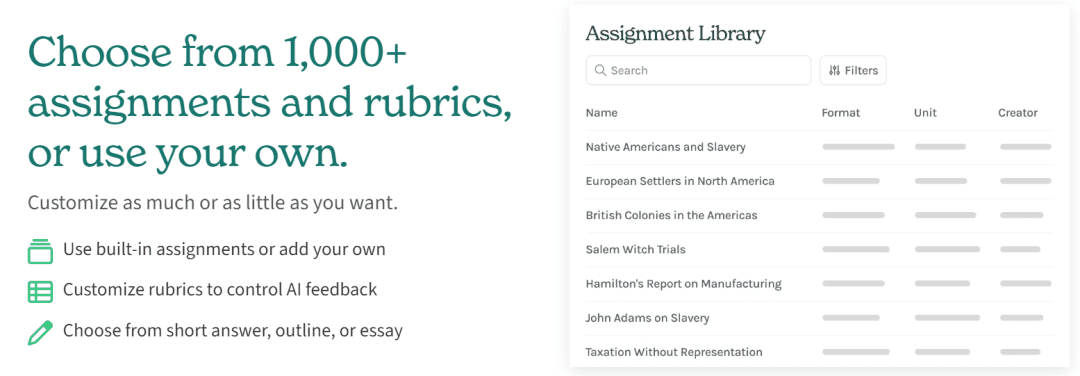
After using AI generation, the teacher can keep prompting the AI and keep revising the assignment.
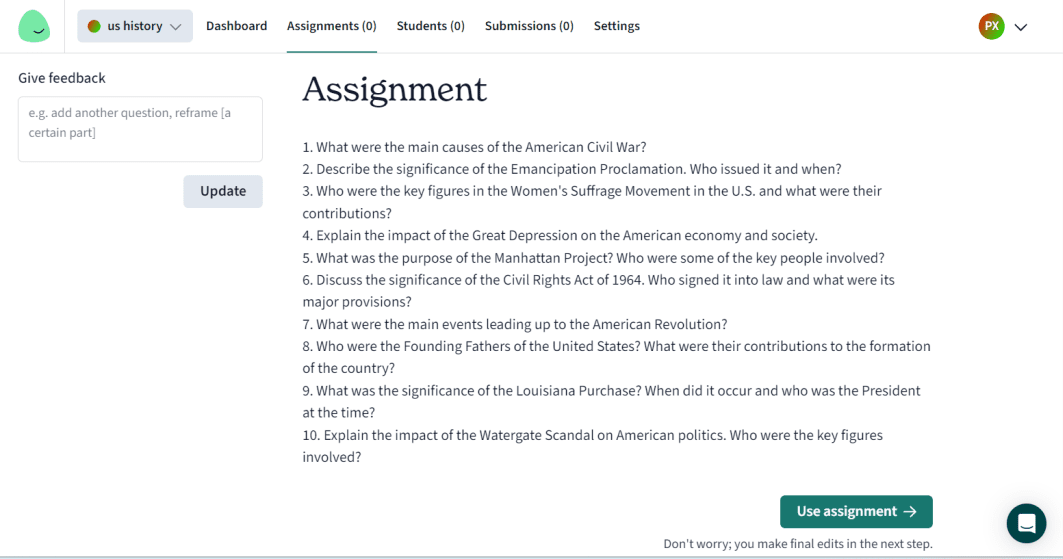
Once the assignment topic has been determined, more detailed settings can be made, including which course section it belongs to, rules for giving AI feedback and scores.

Teachers love the ability to customize feedback by way of prompts, enabling tailored instruction by customizing it for the class and individual students.
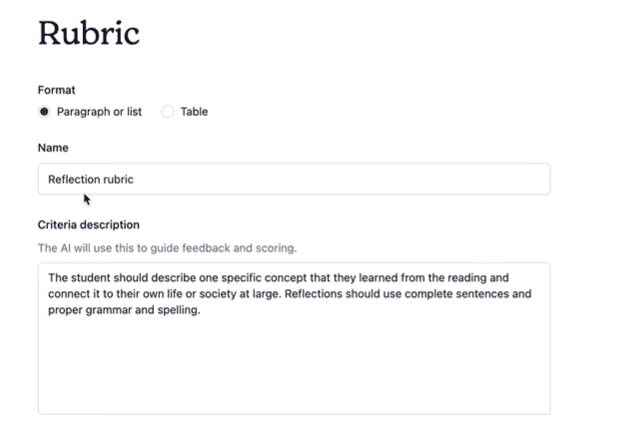

After the student completes the assignment, Class compaion shows the teacher a history of the student's interactions with the AI as well as a report analyzing the results to help the teacher understand the student. Students can also challenge criticisms given by the AI and appeal to the teacher.


By analyzing the teacher interviews released officially by class companion, it can be found that teachers think the core value point of class companion is the ability to provide students with instant feedback, which reduces their burden of correction. Users also perceive LLM's product effectiveness to be more accurate and fair. For example, a California social studies teacher mentioned that he had never corrected after-school exercises because of time constraints, but the use of class companion filled this teaching gap, and the product was well received by students, who would read the questions more carefully and make multiple attempts after receiving feedback, and who considered class companion "relatively fair and objective". Students also found class companion to be "relatively unbiased and objective" and found that their overall writing improved after using it for a while.
In terms of user data, it is officially stated that 10,000+ high school teachers in the U.S. are already using class companion. However, according to simmilarweb, as of May 2024, the number of monthly visits was around 100,000, and the number dropped significantly in June due to the summer vacation. In terms of traffic distribution, the U.S. has the lion's share of the market.

Team & Financing
The team members have multiple backgrounds in education industry, serial entrepreneurs, LLM product development, and graduated from Harvard, MIT and other universities. There are currently 9 members on Linkedin.
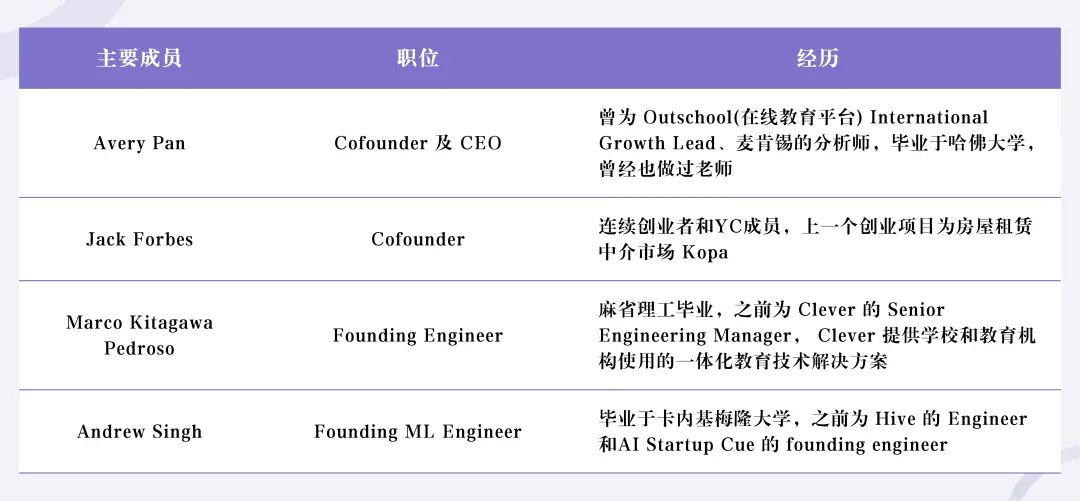
In October 2023, Index Ventures led a $4 million seed round in class companion, followed by OpenAI Startup Fund and Andrej Karpathy and Terrence Rohan, among others.
market research
Class companion is currently using a PLG approach to promote the product, so the most important thing at this stage is to understand the needs of teachers and make them feel the value of the product. class companion offers the product to teachers for free and has set up a teacher community on Facebook.
In terms of instructional software head companies, Instructure, the parent company of Canvas, has annual revenues of $530 million in 2023, and its business is mainly concentrated in North America, occupying a market of 36% in North American higher education institutions. Globally, Instructure's share of the learning management system market is 3.41%. It can be projected that the market size of teaching management software for higher education in North America is about $1.5 billion, and the global market size is about $15.5 billion.
Class Companion's target market is primarily K-12 schools in the United States. According to the National Center for Education Statistics, there are about 2.5 times as many K-12 students as college students, and in 2021 there will be about 130,000 K-12 schools in the U.S. with more than 50 million K-12 students. Most of the products for schools charge for selling student seats. Google Classroom, for example, is divided into a free version, $3/$4/$5 per student pricing tiers. Since there is no LLM product similar to Class companion in the current market, considering the increased cost of LLM inference, referring to Google Classroom's highest tier $5 per students, there is a chance that the potential market size of class campanion in the U.S. could reach 5,000w*5*12=$3 billion. *12=3 billion dollars.
potential competitor
The Class Companion market segment is still in its early days and faces potential competition from two main sources:
- Traditional homework assessment platforms that incorporate LLM feedback: Khanmigo from Khan Academy, as well as Albert.io, Quizlet, Gradescope, and others mentioned above. These products have a large user base and school resources, and can be sold competitively as part of a product portfolio.
- Chegg and other products for k12 students develop teacher-side LLM products:
Chegg develops products mainly for students, and its main business is Chegg Services, an online learning service, including Chegg study, a homework community, Chegg Writing, a writing grammar tool, and Chegg Math, a math problem solving tool. Among them, Chegg Study is to provide homework answer solutions, which is its core profit source.
Chegg's current LLM product is Cheggmate, which customizes lesson plans for students. For example, CheggMate looks at test scores uploaded by students, analyzes strengths, and connects users to job opportunities. chegg has ample accumulation of teaching and research resources and user information, and would be highly competitive if it also develops a set of tools for teachers that incorporate LLM, in conjunction with chegg study.
Future Gen-AI Variables and Implications
The application of GenAI in education is still in its early stages, and some foreseeable variables have raised our expectations for the future development of AI+Education:
1. Multimodal architectures such as GPT-4o bring new scenarios
GPT-4o's new multimodal architecture gives the model visual, auditory, and speaking capabilities, significantly reducing latency. This has the opportunity to unlock more educational application scenarios.
For example, by recognizing students' facial expressions and body language, AI tutor can better understand students' emotional state and regulate teaching content methods. In terms of real-time interaction, it can also optimize the experience of real-time Q&A, speaking practice, and instant feedback. It can also unlock subjects such as painting and design, music learning, and other subjects that require visual and auditory senses in order to provide feedback and guidance.
2. o1 Unlocking reasoning, math skills
o1 has been shown to perform better in the areas of math and reasoning. As math professor Terence Tao argues, o1-preview has been able to reach the average graduate level.

In the future, with the further development of o1, there is an opportunity to help students with the logic of reasoning to answer complex questions, as well as access to more specialized fields, such as engineering, medicine, and so on. At the same time, o1 can also be used as an assistant to teachers and academic research to improve the efficiency of the education system.
© Copyright notes
Article copyright AI Sharing Circle All, please do not reproduce without permission.
Related posts

No comments...



